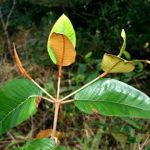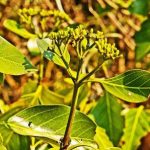TREE LIFE
OCTOBER 1991
MASHONALAND CALENDAR
Tuesday 1st October: Botanic Garden walk with Tom Muller at 4.45 for 5 p.m. Park your car at the Herbarium.
Sunday 20th October: Thetford Farm – Christon Bank/Mazowe area. Reading the account of the society’s last visit to David and Jacquie Narracott in February 1986 we are reminded that this is a very interesting venue featuring Sterculia quinqueloba, Ochna gambleoides, Philippia benghueleneis, Heteropyxis dehniae and Hexalobus monopetalus – just a few of the many interesting trees to be found. The view over Mazowe Dam, we read, is spectacular, as is the Narracott’s garden, where we meet at 9.4Sam.
Saturday 26th October: 3.00 pm at Lake Chivero arboretum to walk with Mark Hyde and George Hall. Many years ago when the dam was constructed some hard working individuals put in many hours of labour digging holes, planting and later caring for trees of all sorts on what was then a very bare hillside. Mark and George will take us through these, now mature, trees and give us some of the history of the arboretum.
Sunday 3rd November: The Aloe Society (ACSS) invite you to attend an all day Giant Car Boot Plant Sale (the first ever) to be held in the National Botanical Garden near the Herbarium in conjunction with (1) a Miniature Garden Display and (ii) The City Centre Treasure Trail which ends at the Herbarium offering a first prize of $75. There are ten easy observation questions on the entry forms which are obtainable now from the Information Bureau at Africa Unity Square, Meikles Hotel and the Monomotapa, or if preferred Vida Siebert will send you one or more. Numerous succulents, aloes, hanging baskets, indigenous trees, African violets, etc. will be on offer and light refreshments will be available.
Tuesday 5th November: Botanic Garden walk.
Sunday 17th November: The Meadows Mtoko Road.
Saturday 23rd November: Walk with Mark in the Mukuvisi woodland.
MATABELELAND CALENDAR
Sunday, 6th October 1991: A morning outing to Matsheumhlope Venue – Val Deas house, 135 Crouch Road. Morning only – bring tea-time and chairs.
Wednesday, 18th October 1991: McHEW at Hillside Dams – 5.00 pm.
Sunday, 3rd November 1991: A new area 75 km out to (and beyond) Nyamandhlovu – all on tar, with about 3 km on to the Glencurragh Farm. Mr. Wood is quite proud of the amount of trees on his 1000 acre farm which ranges from Kalahari sand to rocky kopjes – he might join us and will arrange a picnic area. Keep fingers crossed for leaves and that we might have had some rain by then. All day outing – tea/lunch/chairs. Meet at Falls Road Motors at 8.30 am.
Wednesday, 13th November 1991: McHEW at Hillside Dams – 5.00 pm.
Sunday 1st December 1991: Again out on the Falls Road – but a morning outing to Mguza Nature Reserve 15 km where quite a lot of development has taken place since our last visit. While looking at trees we might trip over a giraffe, tsessebe, zebra, kudu, impala or two, but there should be water in the Lower Mguza dam to support the tree life and the views are quite impressive. Meet at Falls Road Motors at 8.30 am complete with tea time and chairs.
Wednesday, 18th December 1991: The last McHEW of the year at Hillside Dams at 5.00 pm.
Before the New Years party at the Blakes to herald in 1992. Angie Murray has her thinking cap on already to co-ordinate the food – be nice to her.
MATABELELAND NOTES
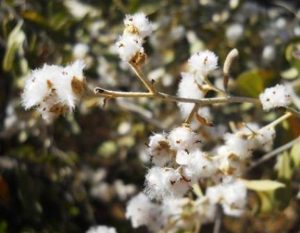
Tarchonanthus camphoratus. Photo:L.E. Lauritsen. Source: Flora of Zimbabwe
Depression is setting in about waterless Bulawayo, and is showing with non attendances at meetings particularly so at the very exciting outing to Mike Paul’s 200 acre plot “Broadleas” in the eastern Matopos in August. A final count of 99 trees, and a lot of expended energy, made up a fabulous outing which ranged from high view – points to low ferny perennial streams. Highlights were the stands of Brachystegia glaucescens, Commiphora marlothii, with its paper-bark waving in the breeze, a few Cussonia spicata var. triptera, proving that they are more widespread than we had at first thought, Euphorbia matabelensis with its striking triple branchlets (flowering), some beautiful Ficus species.- F. glumosa, F. ingens, F. natalensis, F. sur, F. thonningii and F. verruculosa (wartless) – proving that Ian’s trees add greenery to the scenery; while my Pseudolachnostylis maprouneifolia added much colour! Ptaeroxylon obliquum were looking very nice among the rocks, and Schrebera alata with its winged petiole, was a firm favourite with the plots owner, as was the demonstration of the corky bark of Strychnos cocculoides and the oranges of its other species – S. madagascarieneis, S. matopensis and S. spinosa. Tarchonanthus camphoratus was just coming into its white puff-ball flowers, and Vitex payos had plenty of leaves which varied in size from tree to tree.
A most enjoyable day, and the Greek milk tart made up for driving up the scary 1-in-2 rocky hillside to get there (and back!)
AND
August’s McHEW continued the Ficus theme that Ian has a fixation on now a days – understandably so, as they occur in one form or another on all our outings. The unnamed photocopies were great mysteries, as were the answers as Ian had us on edge in a typical teacher manner. We, of course, were supposed to think the problems through to their rightful conclusions, but he eventually relented and we finished up with Ficus thonningii F. sur, F. ingens and our only certainty, F. glumosa!
Be warned, this is an ongoing exercise and I for one learnt a lot in the one evening – thank you, once again, Ian.
AND
After the Bamobata outing in September some of us spent the afternoon in the next door, Matobo Game Park. Whether or not we saw many animals, was immaterial when compared to seeing the magnificent trees in that area.
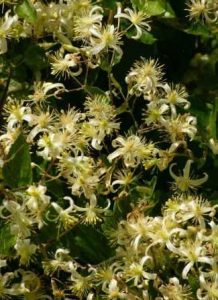
Clematis brachiata. Photo: Bart Wursten. Source: Flora of Zimbabwe
It almost took your breath away to see the gold of the Colophospermum mopane and Burkea africana in the lowering sun, the glorious cauliflower white of Dombeya rotundifolia, Tarchonanthus camphoratus and Clematis brachiata (traveller’s joy) contrasting with the russet apple colour of Flacourtia indica leaves, and the unbelievable kaleidosccope of colours of the many Pseudolachnostylis maprouneifolia against the fantastic rocky backdrops, and then, when we arrived at Mpopoma Dam and were treated to the sound and sight of the African Fish Eagle doing his Barclay’s Bank television stunt, you must realise that we had it made.
There was a disconcerting twinkle in Ian’s eyes as he handed out the photo copies this month, which increased as we were shown the Ficus species which were NOT on the photocopies!
And then followed a most interesting dissertation on the “outside-in figs” and the “inside-out mulberries” – both members of the same Family – MURACEAE. In the new seek and-learn method of teaching, the intricacies of life in and around the fig fruit/flowers was explained down to our level and everybody was amazed.
For those who were a bit confused during the evening, we saw Ficus thonningii , F. ingens and F. abutilifolia — I think!
As a member summed it up – “What a super evening, roll on part three” – thank you Ian.
-KEN BLAKE
On Sunday 1st September we went to the Matopos, to the Bambata Cave Area. Before attempting the lengthy climb, we investigated the area below, around where we left the cars. There are many interesting species on the Tops as well. In June 1990 we found 81 species. This Sunday, we managed 67. As many trees were leafless this was quite creditable. In point of fact, we failed to find 7 of the previous lot, but we did find an additional 13, to get our 87. Had we spent longer below, I feel that we might have found a few more. I definitely think, that this area ranks with the Efifi one, for variety of species.
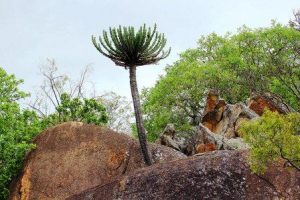
Euphorbia cooperi. Photo: Bart Wursten. Source: Flora of Zimbabwe
The additions we located were Afzelia quanzensis, Aloe excelsa, Combretum zeyheri, Crossopteryx febrifuga, Euphorbia cooperi, Euphorbia ingens, Ficus natalensis, Rhus lancea, Sesbania sesban, Strychnos pungens, Ochna pulchra, Trema orientalis, Celtis africana.
Incidentally, we have not encountered Celtis before at a Bushman site, whereas they are always prominent at all the Ruins sites, in this part of the country. One wonders, why?
Other trees of interest were: large groups of Brachylaena rotundata, all very white, Catha edulis frequent, Combretum collinum, C. erythrophyllum, Heteropyxis dehniae, many, in varying shades of red, some quite spectacular, Maytenus heterophylla, subsp. puberula, the Matopos subspecies, Mimusops zeyheri, Nuxia congesta, Ochna glauca, Pavetta eyleslii, Pterolobium stellatum, in splendid full fruit, Tarchonanthus camphorates, flowering very heavily and competing with Clematopsis, also what we hoped was Teclea rogersii, (or Vepris reflexa).
Apparently they are difficult to separate, except when in flower. But, this was more a shrub, also perhaps a pointer to Teclea. Anyway, it was a good and rewarding day, climate wise too, after a rather cold and miserable start in Bulawayo.
–C. SYKES
HERBARIUM NUMBERS AND ZIMBABWE NUMBERS
In last months Tree Life, Benedicta Graves asked if the Herbarium Number was the same as the National Tree List Number. The short answer is no: The longer explanation is this:
To make some order out of the thousands of plant species worldwide, many different classifications have been, and still are being produced by different botanists. These place the plants, according to their opinion, in a sequence of families and genera, primitive to advanced. Kim’s Footnote, Tree Life No. 118 (Dec. 89) will explain this.
The system used by the Harare Herbarium and by the one in Pretoria among others is an early one arranged by Engler and Prantl. We should be familiar with this arrangement as it is also used by Coates Palgrave in Trees of Southern Africa. 33 families and genera arranged in a primitive to advanced sequence while the species within each genus arranged alphabetically.
To the botanical sequence was added a system of numbering by de Dalla Torre and Harms (1900-1907) in their publication Genera Siphonogamarum. Each species was allocated a number consecutively through the list. This is the HERBARIUM NUMBER and is internationally recognised and used.
In 1975 Mr Bob Drummond extracted from the de Dalla Torre and Harms list those trees, shrubs and woody climbers indigenous to, or naturalised in Rhodesia and numbered them consecutively from 1 (Cyathea capensis) to 1172 (Chrysanthemoides monilifera). This is the NATIONAL TREE LIST NUMBER.
In Coates Palgrave’s book we can usually see two numbers under each species; the Zimbabwe Tree Number and a South African one which was arrived at in the same way as Bob Drummond’s by B. de winter and F. von Breitenbach.
Taking Adansonia digitata (Baobab) as an example, we get:
5023 (International)
684 (National)
457 (National)
This one question answered raises others. Tree List Numbers when names are changed? Why do they change? Who decides that they should ? More next month.
18 AUGUST 1991: HARARE OUTING TO ROCKY MOUNTAIN FARM CONCESSION
At rather short notice, our original venue for this months outing was cancelled due to shortage of leaves. (This is at least one shortage which you can’t blame on the Government!) So we are especially grateful to Geoff Hawksley for stepping in as our host for a day which yielded a bumper harvest of quality ticks on our tick lists.
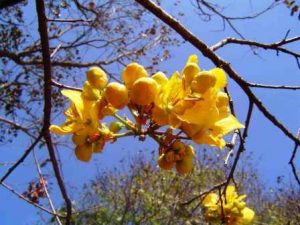
Senna singueana. Photo: Bart Wursten. Source: Flora of Zimbabwe
After a very welcome tea, we convoyed down to an area where the river bounded a steep hillside. On our may upstream from the site where we parked our cars, the first eye catcher was the brilliance of the flowers of Senna singueana, the winter flowering cassia. The bright yellow splashes on a leafless tree and in rather faded khaki coloured bush were quite something. A little along the path were large numbers of large Dodonaea viscosa heavily laden with their three-winged fruit which, at first glimpse strongly resemble those of combretum, which are in fact invariably four-winged. Also along this path were a couple of Bauhinia thonningii (Piliostigma) laden with their monkey-bread pods.
Descending into the riverine forest we started coming across some more interesting material. There were Mimusops zeyheri and Baquaertiodendron magalismontanum, both members of the SAPOTACEAE family. In the canopy above was a fairly large tree with some unusual large leaves turning red which set the old clockwork in our heads whirring until the one or two of us who had been on the Chimanimani trip recognised it as the same thing seen there, namely, Bridelia micrantha. Forming this canopy were large waterberry trees, Syzygium cordatum and Combretum erythrophyllum, the river combretum. There was Celtis africana, a few Ilex mitis then Rapanea melanophloeos, and lots of Myrica serrata. Predictably, there were the usual denizens of the sandy river bed, Salix subserrata, the African willow, and Rhus quartiniana, the river rhus.
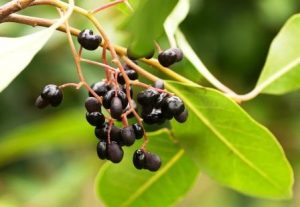
Apodytes dimidiata. Photo: Bart Wursten. Source: Flora of Zimbabwe
Coming up the river bank, I saw what 1 thought was a small stand of young gum trees, and though it was quite clear, on closer inspection, that they weren’t, I was, I confess, stumped. These turned out to be Catha edulis, and I suppose that the fact these were in red autumn colours helped to fool me. Close by was another one that had me guessing, because although I recognised it (honestly!), I Just couldn’t get the name. It turned out to be Apodytes dimidiata, which in the same vein as Ilex mitis has a pinkish petiole which also carries a groove along its upper surface, running into the midrib of the leaf. A little further up the rocky hillside was another surprise in store. This was the other member of the elm Family (ULMACEAE), (the first being Celtis africana), by the name of Trema orientalis, known charmingly by its common name of pigeon wood. The distinguishing factor of this tree as against Celtis is the fact that the serrations of the margin of the leaf, which in any case are finer, continue all the way to the base whereas with Celtis the serrations only reach about two thirds of the way down to the base from the apex of the leaf.
Geoff showed us the remains of an extraordinary engineering work put in a decade ago by an earlier occupant. This was a small irrigation canal which wound its way along a contour, though falling almost in-discernibly, to allow the water when it ran to run. How our late Jack Reid (a surveyor by profession) would have admired this. Perhaps he even surveyed it, who knows? In this area were some other pretty interesting finds such as some large Euphorbia griseola and, more unusual, some Synadeniun sp. the dead mans tree, also of the Euphorbia family. Look in your Coates Palgrave for the exaggerated stories of its undoubted toxicity, such as the story of the ground around the trees being littered with the bones of dead animals, and the birds foolish enough to fly overhead which fall dead from the sky.
The trees were too many to mention all. Lunch time found us languidly lolling at an idyllic picnic spot on the river where, laughingly it spills over a small waterfall in a sandy opening of the canopy surrounded by the verdant greenery. OK, I’ll give up the flowery prose, I promise.
After lunch, we drove downstream to a drier area along the river. Here I especially recall the smaller fruited bush orange, Strychnos innocua. There was a of the furry leafed Protea welwitschii however the flowers were, sadly, long gone. Close to a large termite mound was a violet tree, Securidaca longepedunculata remarkable for its considerable height. The termite mound was replete with Ehretia obtusifolia.
And so at the end of another great day we retired again to Geoff’s cool verandah to sip more very welcome tea whilst admiring his mature forest mahogany, Trichellia dregeana in his garden, and also the fruiting raphia palm Raphia farinifera. Many thanks go to Geoff.
J.P. Haxen
VISIT TO STANLEY FARM, CHEGUTU: SEPTEMBER 1991
This is not the time of year in which our deciduous indigenous trees conceal their structural secrets behind a veil of leafy drapery. Trunk and limbs stand stark in many cases, particularly so in an area where a succession of dry years has culminated in a “rainy” season of 11.5 inches, and the altitude is a little below 4000 feet. An expedition to that dry countryside might not, therefore, be regarded as an interlude of visual enchantment. Yet one can find endless fascination in the form and fabric of nature’s architecture – and a lot of stimulation and fun in sorting out one leafless tree from another. Besides which, notwithstanding the impression of unrelieved drabness that this introduction might give, the dry countryside miraculously produces, in some plants, green-ness of leaf and brightness of flower that is particularly refreshing in contrast to the greys and grey-browns in the vicinity.
The warmth of welcome to Stanley Farm, Chegutu, on the 15th September, by Brian and Jennifer Watkins and their son Graham, was the first of a succession of pleasures that came our way.
It is nine years since we first marvelled at the splendour of the Watkins fig tree – a Ficus sansibarica of impressive size (and on that occasion in full leaf) standing, with buttresses, within the circle of lawns and flowering shrubs that grace the surrounds of the homestead. Following that visit, Brian, on request, supplied the following measurements, taken in March, 1982:-
Circumference of trunk at 1.2m above ground level 5.38 m
Estimated height 13.50 m
Lateral spread of branches 34.00 m
The estimate of height provided ammunition for some gentle banter on the charge that there had been collusion between father and son. Graham was accused of having posed at various levels, in scaling the tree, while father, knowing his sons height, took a series of guesses at the amount of tree retraining above and below him. These libellous accusations notwithstanding, the tree is a wonder to behold, and Brian’s trusty steel tape bears witness to the authenticity of the magnificent spread of the branches. The height is not exceptional, but the spread certainly is, for a tree of that height, and its symmetry is most pleasing. On this occasion, the tree had only a scattering of its rather elongated leaves, but some of the branches were liberally studded with fairly large figs, in the manner characteristic of the species.
In consultation with Brian, Mrs. Ann Bianchi then directed us to the banded ironstone ridges that rise from the basin into which water is pumped from the Mupfure River, to form a storage dam for Chegutu. Ann’s quietly knowledgeable reccee of the places we visit around Chegutu from time to time, are invaluable, and when we arrive she manages invariably to suggest a route, as if by chance, uphill or down dale, that leads us to “finds” of special note.
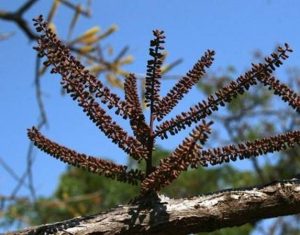
Elephantorrhiza goetzei. Photo: Mark Hyde. Source: Flora of Zimbabwe
The mornings walk along the ridge took us past scores of leafless trees and shrubs –
Lannea discolor, Dichrostachys cinerea, Kirkia acuminata, and the thorny Canthium frangula among them. A leaf or two gave the game away with Pseudolachnostylis maprouneifolia and Dalbergia nitidula. D. melanoxylon refused, for the most part, to compromise in that way. In fruit were Diplorhynchus condylocarpon, Rothmannia fischeri, Strychnos spinosa, Gardenia ternifolia, Pterocarpus angolensis, Combretum zeyheri and several species of Acacia. Fruit and flowers were displayed by other species such as Combretum hereroense (in profusion) and Capparis tomentosa. Of special delight to the eye were Cassia abbreviata, Boscia salicifolia and Albizia antunesiana, all in flower. Elephantorrhiza goetzei was also flowering, and, together with an attractive small Maerua, not positively identified as to species because we rather passed it by, and a charming little Convolvulus or some sort, and a graceful Steganotaenia araliacea. Others too, but pride of place for excitement among the flowering plants had to go to Haplocoelum foliolosum. This was first spotted on the farm by Mrs. Gill Masterson in 1982,and was described by Meg Coates Palgrave at the time as ” ….a member of SAPINDACEAE …. (with) a pinnate leaf (bearing) 3 – 14 pairs of opposite leaflets which are very asymmetric, so much so that the midrib appears to run diagonally across the leaflet instead of down the centre”. The latter very marked feature we again pointed out by Kim on this trip.
The yellowing leaves of Diospyros kirkii were much in evidence, and, all over the place too was Tarenna neurophylla in leaf. A Pappea capensis stood proud and green in an otherwise dry-looking spot and a solitary Colophospermum mopane looked down on it from a little way off. Leafing in virile freshness on the crest of the ridge was a fine specimen of Mimusops zeyheri, and in generous leaf, also, were Olax dissitiflora, Erythroxylum emarginatum, Euclea natalensis, Cassine aethiopica and C. matabelica. Most prized among the leafing plants perhaps, because we don’t often see them, were Hippocratea parvifolia with prominent climbing tendrils (rather alarmingly disfigured by waxy scale insects – Ceroplastes sp. ) and Manilkara mochisia. The latter was a joy, gracefully displaying its rosettes of leaves for admiration. Brachystegia glaucescens looked on from the higher vantage points.
In the afternoon, a short journey around the kopje brought within our view, within a remarkably small radius, an exceptionally interesting assortment of Acacias – A, gerrardii, A. goetzei, A. karroo, A. amythethophylla, A. nilotica, A. polyacantha, A. rehmanniana and A. galpinii, and as a climax to the outing, another most notable fig, Ficus nigropunctata. This Ficus is another outstanding feature of our Chegutu expeditions, although not always found even in that area. We recorded it on Mr. Jack Bowens Farm in June 1978, and again on Mr. C. Cloete’s farm in May 1985. The figs are small; the leaves are described in Palgrave as finely velvety on the under surface, and it seems from our few field observations that the leaf margin can vary from entire to finely serrate. The sturdy young trunk of the tree found for us by Ann on this trip was green. At the time of the visit to Mr. Cloete’s farm, Kim wrote – “Current fig theory believes that even these rarer species are pollinated by their own species of wasp. This does seem remarkable although it would be interesting to know how common they are in local patches. It is of interest to note, from a recent issue of the journal “Trees in South Africa”, that our old friend Mr. Denzil Carr has, rather to his own surprise, successfully propagated a nunber of Ficus lutea plants from seed from over-ripe figs that fall onto his car from an “introduced” tree under which he had parked at Loskop Dam in the Eastern Transvaal. “This tree”, he writes, “does not occur in the Loskop Dam area, the nearest of the species being in Mozambique to the east of Swaziland and at low altitude. The associated wasp species would thus also be that far distant.” Mr Carr gives the checklist of naturally occurring Ficus species in the Loskop dam Nature Reserve as F. abutifolia, F. craterostoma, F. glumosa, F. ingens, F. natalensis, F. salicifolia, F. sur and F. thonningii. He muses – “Do our figs always obey the rules?”
Well, this rambling account must stop somewhere. Our thanks to Brian and Jennifer and Graham for their warm welcome, and their interest and guidance and hospitality throughout the day. We wish them well with their farming and horticultural activities. We would like them to know that it was a pleasure also to meet their friends and neighbours.
Anne Bianchi has received most welcome parcels of seeds from all over Zimbabwe, including Fort Rixon, Kariba, Bulawayo, Harare and Chegutu all of which have enabled her to make a very generous donation to the Society. Thank you all very much.
-Kim Damstra
TIMBER-FELLING: NYANGA NATIONAL PARK
Before 1948 the area now known as Nyanga National Park was part of the Rhodes Nyanga Estate and was managed as a farm. At that time land was given over to plantations of various tree species in an effort to find viable sources of income for the Estate. Amongst others, 70 hectares of the self seeding pine tree, Pinus patula were planted between 1937 and 1966. The consequences of these plantations have created severe conservation problems through rapid encroachment of the tree through the Park area as well as increasing the natural acidity of soils and water bodies. Certain areas of the Park are in danger of losing indigenous and endemic plants and sight of the natural vegetation will become an historical one. Additionally, many of the trees in the older stands are dying naturally and are therefore not serving the purpose for which they were originally planted.
Since the intentions of the Department of National Parks and Wild Life Management are to maintain National Parks as far as possible in their pristine condition, it becomes necessary to not only remove the plantations before the falling timber becomes a hazard to the public, but also to remove the seed source of the encroaching pine trees. It is anticipated that this will be done over several years and that every effort will be made to ensure the rehabilitation of the felled areas. It is likely that for certain periods of time areas will appear barren, but with the high rainfall experienced, rejuvenation is expected to be relatively rapid.
The primary concerns for the Exotic Timber Control Program are the prolific self-seeding trees namely wattle and pine. There is no intention in the foreseeable future to denude the National Park of all exotic trees such as the gums, oaks and cypress trees. where the timber is stable in the ecosystem the trees will be left for all to enjoy.
EXTRACT FROM “ZIMBABWE PARKABOUT” June 1991
KIM DAMSTRA CHAIRMAN


